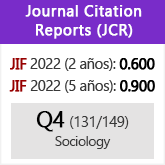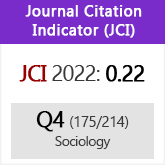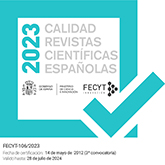¿Quiénes somos? Influencia de los padres en la identidad y la auto-estima de los jóvenes de segunda generación en España
DOI:
https://doi.org/10.3989/ris.2011.09.26Palabras clave:
Aculturación disonante, Aculturación selectiva, Auto-estima, España, Identidad nacionalResumen
Examinamos la literatura sobre los determinantes de las auto-identificaciones étnicas y nacionales y la autoestima como paso previo para el análisis de tales resultados en una muestra numerosa y estadísticamente representativa de adolescentes de segunda generación en Madrid y Barcelona. A pesar de que estas variables psico-sociales son altamente maleables en la adolescencia, representan de todos modos dimensiones importantes del proceso de adaptación de los hijos de inmigrantes con consecuencias potencialmente significativas para su avance individual y movilizaciones colectivas. Las teorías existentes sobre el tema se basan fundamentalmente en estudios conducidos en Estados Unidos y otros países anglófonos. La existencia de una nueva muestra de la segunda generación española nos permite poner a prueba estas teorías en un contexto socio-cultural enteramente distinto. Además de incluir datos sobre cerca de 7.000 jóvenes de segunda generación, el estudio incluye también una muestra representativa de sus padres. Esto nos permite examinar directamente cómo las características de los padres afecta a la adaptación psico-social de sus hijos. Se examinan las implicaciones teóricas y prácticas de los resultados.
Descargas
Citas
Aguilar San Juan, K. 2005. “Staying Vietnamese: Community and Place in Orange County and Boston.” City and Community 4:37-65. http://dx.doi.org/10.1111/j.1535-6841.2005.00102.x
Altschul, I., D. Oyserman, and D. Bybee. 2008. “Racial-Ethnic Self-Schemas and Segmented Assimilation: Identity and the Academic Achievement of Hispanic Youth.” Social Psychology Quarterly 71:302-320. http://dx.doi.org/10.1177/019027250807100309
Andall, J. 2002. “Second-generation attitude? African-Italians in Milan.” Journal of Ethnic and Migration Studies 28:389-407. http://dx.doi.org/10.1080/13691830220146518
Aparicio, R. 2006. Hijos de inmigrantes se hacen adultos. Madrid: Observatorio Permanente de la Inmigración, Ministerio de Trabajo e Inmigración.
Aparicio, R. and A. Tornos. 2008. Aproximación al estudio de las bandas latinas en Madrid. Madrid: Ministerio de Trabajo e Inmigración.
Arriagada, P. A. 2007. “In search of an identity in young adulthood: Ethnic self-identification among children of immigrants.” Ohio State University.
Aunion, J. 2010. “El abandono escolar solo existe entre extranjeros”. El País, July 14, pp. 28-29.
Bailey, B. 2000. “Language and Negotiation of Ethnic/Racial Identity Among Dominican Americans.” Language in Society 29:555-582. http://dx.doi.org/10.1017/S0047404500004036
Bailey, B. 2001. “Dominican-American Ethnic/Racial Identities and United States Social Categories.” International Migration Review 35:677-708. http://dx.doi.org/10.1111/j.1747-7379.2001.tb00036.x
Barbulo, T. 2009. “La crisis económica frena en seco la llegada de immigrantes”. El País April 4, p.12.
Borasteros, D. 2011. “Baja el numero de immigrates por las nacionalizaciones de los ecuatorianos.” El País. April 13, p.6.
Cachón, L. 2009. La España immigrante. Barcelona: Anthropos.
Calavita, K. 2005. Immigrants at the Margins: Law, Race, and Exclusion in Southern Europe. Cambridge, UK: Cambridge University Press. http://dx.doi.org/10.1017/CBO9780511493942
Carvajal Gómez, M. I. 2006. “Evolución de las cifras de extranjeros con tarjeta de autorización en vigor.” Pp. 85-112 in Veinte años de inmigración en España: Perspectivas jurídicas, edited by E. Aja and J. Arango. Barcelona: Fundación CIDOB.
Diehl, C., and R. Schnell. 2006. “Reactive Ethnicity or Assimilation? Statements, Arguments, and First Empirical Evidence for Labor Migrants in Germany.” International Migration Review 40: 786-816. http://dx.doi.org/10.1111/j.1747-7379.2006.00044.x
Díez Nicolás, J. 2006. Las dos caras de la inmigración. Madrid: Observatorio Permanente de la Inmigración, Ministerio de Trabajo e Inmigración.
Duncan, B., and Stephen J. Trejo. n.d. “Ancestry Versus Ethnicity: The Complexity and Selectivity of Mexican Identification in the United States.” SSRN eLibrary. http://papers.ssrn.com/sol3papers.cfm?abstract id 1150721 (Accessed October 15, 2009).
Farver, Jo A. M., S. K. Narang and B. R. Bhadha. 2002. “East meets West: Ethnic identity, acculturation, and conflict in Asian Indian families.” Journal of Family Psychology 16:338-350. http://dx.doi.org/10.1037/0893-3200.16.3.338 PMid:12238415
Feliciano, C. 2009. “Education and Ethnic Identity Formation among Children of Latin American and Caribbean Immigrants.” Sociological Perspectives 52:135-158. http://dx.doi.org/10.1525/sop.2009.52.2.135
Feliciano, C. and R. Rumbaut. 2005. “Gendered Paths: Educational and Occupational Expectations and Outcomes Among Adult Children of Immigrants.” Ethnic and Racial Studies 28 (November): 1087-1118. http://dx.doi.org/10.1080/01419870500224406
Firebaugh, G. 2008. Seven Rules for Social Research. Princeton, NJ: Princeton University Press.
Fishman, J. A. 1981. “Language Maintenance.” Pp. 629-38 in Harvard Encyclopedia of American Ethnic Groups, edited by Stephan Thernstrom. Cambridge, MA: Harvard University Press.
Glazer, N. 1954. “Ethnic Groups in America.” Pp. 158-73 in Freedom and Control in Modern Society, edited by T. A. M. Berger, and C. Page. New York: Van Nostrand.
Golash-Boza, T. 2006. “Dropping the Hyphen? Becoming Latino(a)-American through Racialized Assimilation.” Social Forces 85:27-55. http://dx.doi.org/10.1353/sof.2006.0124
Grascia, A. M. 2004. “Gang Violence: Mara Salvatrucha-Forever Salvador.” Journal of Gang Research 11 (2):29-36.
Gualda, E. 2009. “Aspiraciónes y expectativas educativas y laborales de jóvenes inmigrantes e hijos de inmigrantes escolarizados.” Paper presented at the VI Congress of Migration to Spain, La Coruña, Galicia (September).
Hakuta, K. 1986. Mirror of Language: The Debate on Bilingualism. New York: Basic Books.
Hughes, D. et al. 2006. “Parents ethnic-racial socialization practices: A review of research and directions for future study.” Developmental Psychology 42:747-770. http://dx.doi.org/10.1037/0012-1649.42.5.747 PMid:16953684
Jiménez, T. R. 2008. “Mexican Immigrant Replenishment and the Continuing Significance of Ethnicity and Race.” American Journal of Sociology 113:1527-1567. http://dx.doi.org/10.1086/587151
Kish, L. 1967. Survey Sampling. New York: Wiley.
Lieberson, S. 1980. A Piece of the Pie, Blacks and White Immigrants Since 1880. Berkeley: University of California Press.
López, D. E. 1982. Language Maintenance and Shift in the United States Today: The Basic Patterns and Their Social Implications. Volume 1-4. Los Alamitos, CA: National Center for Bilingual Research.
Louie, V. 2006. “Growing Up Ethnic in Transnational Worlds: Identities Among Second-Generation Chinese and Dominicans.” Identities: Global Studies in Power and Culture 13:363-394. http://dx.doi.org/10.1080/10702890600838118
Macias, T. 2004. “Imaginándose Mexicano: The Symbolic Context of Mexican American Ethnicity Beyond the Second Generation.” Qualitative Sociology 27:299-315. http://dx.doi.org/10.1023/B:QUAS.0000037620.32416.cc
Maruyama, G. 1998. Basics of Structural Equation Modeling. Thousand Oaks, CA: Sage.
Observatorio Permanente de la Inmigración. 2009. Statistical Bulletin on Foreigners and Immigration to Spain 19. Madrid: Ministerio de Trabajo e Inmigración (http://extranjeros.mtin.es)
Ono, H. 2002. “Assimilation, Ethnic Competition, and Ethnic Identities of U.S.-Born Persons of Mexican Origin.” International Migration Review 36: 726-745. http://dx.doi.org/10.1111/j.1747-7379.2002.tb00102.x
Pajares, M. 2009. “La inmigración en España: sus causas y las políticas con las que se gestiona” Pp. 175-192 in Las migraciones en el mundo edited by F. Checa Olmos, C. Checa, and A. Arjona. Barcelona: Icaria.
Perlmann, J. 2005. Italians Then, Mexicans Now: Immigrant Origins and Second Generation Progress 1980-2000. New York: Russell Sage Foundation and the Levy Institute.
Portes, A. and M. Zhou. 1992. “Gaining the Upper Hand: Economic Mobility Among Immigrant and Domestic Minorities.” Ethnic and Racial Studies 15:491-522. http://dx.doi.org/10.1080/01419870.1992.9993761
Portes, A. and D. MacLeod. 1996. “What shall I call myself? Hispanic identity formation in the second generation.” Ethnic & Racial Studies 19:523-547. http://dx.doi.org/10.1080/01419870.1996.9993923
Portes, A. and R. G. Rumbaut. 2001. Legacies: The Story of the Immigrant Second Generation. Berkeley, CA: University of California Press and Russell Sage Foundation.
Rosenberg, M. 1965. Society and Adolescent Self-Image. Princeton, NJ: Princeton University Press.
Rumbaut, R. G. 2004. “Ages, Life Stages, and Generational Cohorts: Decomposing the Immigrant First and Second Generations in the United States.” International Migration Review 38 (Fall):1160-1205.
Rumbaut, R. G. 2005. “Turning Points in the Transition to Adulthood: Determinants of Educational Attainment, Incarceration, and Early Childbearing among Children of Immigrants.” Ethnic and Racial Studies 28 (November): 1041-1086. http://dx.doi.org/10.1080/01419870500224349
Rumbaut, R. G. and A. Portes. 2001. Ethnicities: Children of Immigrants in America. Berkeley: University of California Press and Russell Sage Foundation.
Santa-Olalla, G. 2010. “La ausencia de immigrantes se frenó en el 2009”. El Mundo. April 30, pp. 17-18.
Schneider, C. L. 2008. “Police Power and Race Riots in Paris.” Politics and Society. 36(1): 133-159. http://dx.doi.org/10.1177/0032329208314802
Sotelo, I. 2005. “La gran contradicción europea.” El País (Madrid), October 30. P. 15.
Van Niekerk, M. 2007. “Second-Generation Caribbeans in the Netherlands: Different Migration Histories, Diverging Trajectories.” Journal of Ethnic and Migration Studies 33: 1063-1081. http://dx.doi.org/10.1080/13691830701541580
Torreblanca, J. I. 2010. “¿Dónde están los inmigrantes?” El País, January 25. P. 10.
Vigil, J. D. 2002. A Rainbow of Gangs: Street Cultures in the Mega-City. Austin, TX: University of Texas Press.
Waters, M. 1996. “West Indian Family Resources and Adolescent Outcomes.” Paper presented at the meetings of the American Association for the Advancement of Science, Baltimore. February.
Zarate, M. E., F. Bhimji, and L. Reese. 2005. “Ethnic Identity and Academic Achievement Among Latino/a Adolescents.” Journal of Latinos & Education 4:95-114. http://dx.doi.org/10.1207/s1532771xjle0402_3
Zhou, M. and C. N. Bankston III. 1996. “Social Capital and the Adaptation of the Second Generation: The Case of Vietnamese Youth in New Orleans.” Pp. 197-220 in The New Second Generation, edited by A. Portes. New York: Russell Sage.
Zhou, M., J. Lee, J. A. Vallejo, R. Tafoga-Estrada, Y. Soa Xiong. 2008. “Success Attained, Deterred, and Denied: Divergent Pathways to Social Mobility in Los Angeles. New Second Generation.” Annals of the American Academy of Political and Social Sciences 620 (November): 37-61. http://dx.doi.org/10.1177/0002716208322586
Descargas
Publicado
Cómo citar
Número
Sección
Licencia
Derechos de autor 2012 Consejo Superior de Investigaciones Científicas (CSIC)

Esta obra está bajo una licencia internacional Creative Commons Atribución 4.0.
© CSIC. Los originales publicados en las ediciones impresa y electrónica de esta Revista son propiedad del Consejo Superior de Investigaciones Científicas, siendo necesario citar la procedencia en cualquier reproducción parcial o total.Salvo indicación contraria, todos los contenidos de la edición electrónica se distribuyen bajo una licencia de uso y distribución “Creative Commons Reconocimiento 4.0 Internacional ” (CC BY 4.0). Puede consultar desde aquí la versión informativa y el texto legal de la licencia. Esta circunstancia ha de hacerse constar expresamente de esta forma cuando sea necesario.
No se autoriza el depósito en repositorios, páginas web personales o similares de cualquier otra versión distinta a la publicada por el editor.

















